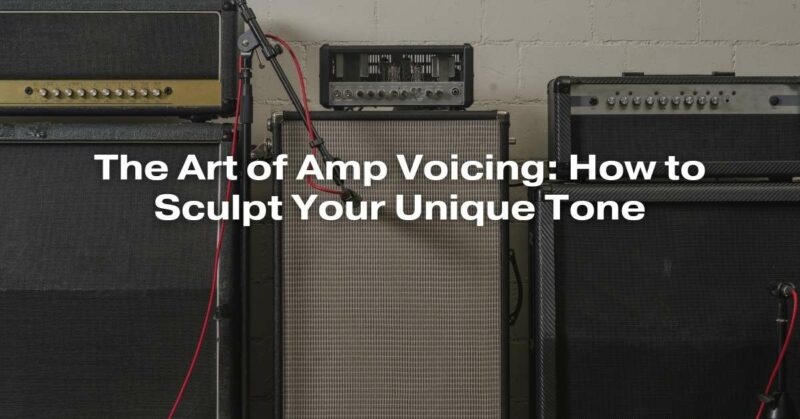Music is a universal language, and for many musicians, their instrument of choice is the guitar. Whether you’re a professional guitarist or just strumming away in your bedroom, one of the most critical aspects of your sound is the amplifier, or amp for short. The art of amp voicing is the process of shaping and sculpting your unique guitar tone through your amplifier, and it’s a skill that can set you apart from the rest. In this comprehensive article, we’ll explore the ins and outs of amp voicing, from the basics to advanced techniques, and help you discover your own signature sound.
Understanding the Basics
Before diving into the intricate details of amp voicing, let’s establish a foundational understanding of what exactly it entails.
1. Amplifiers 101
An amplifier is an electronic device that takes the weak electrical signal generated by your guitar’s pickups and boosts it into a powerful signal that can drive a speaker. Amplifiers come in various types, including tube, solid-state, and digital modeling amps. Each type has its unique characteristics and tonal qualities.
2. The Role of Tubes
Tube amplifiers, often referred to as “valve” amps, are known for their warm, organic sound. Tubes play a vital role in shaping the overall tone of a tube amp. The number and type of tubes used, as well as their configuration (e.g., Class A, Class AB), greatly impact the amp’s voicing.
3. Equalization
Most amplifiers feature an EQ section that allows you to adjust the bass, midrange, and treble frequencies. Understanding how these controls work and their impact on your tone is crucial. For example, increasing the bass will add warmth and depth, while boosting the treble can provide clarity and sparkle.
4. Gain and Distortion
Gain and distortion controls affect the amount of overdrive or distortion in your sound. Different amps and genres may require varying levels of gain, from crystal-clear clean tones to full-throttle distortion.
5. Speaker Choice
The choice of speaker in your amplifier cabinet is another critical factor in amp voicing. Different speakers have distinct tonal characteristics, such as brightness, warmth, and punch. Experimenting with different speakers can significantly alter your sound.
Finding Your Signature Sound
Now that you have a basic understanding of the components involved in amp voicing, let’s explore how to find your unique tone.
1. Know Your Genre
Your choice of music genre plays a significant role in shaping your amp voicing. Blues players may prefer warm, vintage tones, while metal guitarists opt for high-gain distortion. Identify your primary genre and listen to iconic players within that style to understand the tonal characteristics you’re aiming for.
2. Experiment with Amp Settings
Don’t be afraid to tweak your amp’s settings. Start with a flat EQ, then make small adjustments to bass, midrange, and treble to sculpt your tone. Experiment with different gain levels until you find the right amount of overdrive or distortion for your style.
3. Explore Tube Swapping
If you have a tube amplifier, consider experimenting with different tubes to alter its voicing. Changing tubes can lead to subtle or significant tonal shifts. Consult with a professional technician if you’re unsure about tube compatibility.
4. Pedals and Effects
Effect pedals can be powerful tools for further shaping your sound. Reverb, delay, chorus, and various distortion or overdrive pedals can add depth and character to your tone. Experiment with different pedal combinations to achieve unique textures.
5. Speaker Selection
If you have an amplifier with a removable speaker, swapping it out for a different one can dramatically change your tone. Research various speaker models and their tonal characteristics to find one that suits your style.
6. Listen and Learn
Listen to your favorite guitarists and study their tone. Try to identify the specific qualities that make their sound unique. While you don’t want to copy them outright, understanding what you like about their tone can guide your voicing choices.
Advanced Amp Voicing Techniques
For those looking to take their amp voicing skills to the next level, consider these advanced techniques:
1. Amp Modification
Professional amp technicians can modify your amplifier to tailor it to your specific preferences. This can involve circuit modifications, component upgrades, or even custom-built amplifiers designed from the ground up.
2. Impulse Responses (IRs)
IRs are digital profiles of speaker cabinets and microphone placements. Many digital modeling amps and software allow you to load IRs, giving you access to a vast library of speaker and microphone combinations to fine-tune your tone.
3. Studio Techniques
In a recording studio, engineers often use microphone placement and room acoustics to capture unique guitar tones. Experimenting with microphone placement can help you achieve studio-quality sounds.
Conclusion
The art of amp voicing is a journey of self-discovery for guitarists. It’s about sculpting a sound that represents your musical identity and artistic vision. Whether you’re a beginner exploring your first amplifier or a seasoned pro looking to refine your signature tone, the key is to experiment, listen, and adapt. Embrace the endless possibilities that amp voicing offers, and remember that your unique tone is a reflection of your musical journey and creativity.


